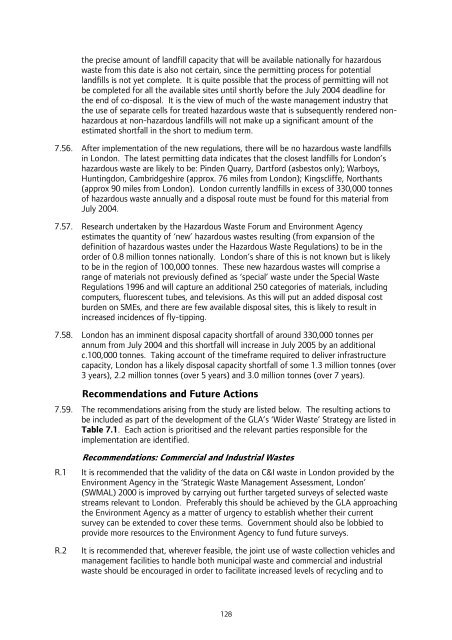London Wider Waste Strategy - London - Greater London Authority
London Wider Waste Strategy - London - Greater London Authority
London Wider Waste Strategy - London - Greater London Authority
Create successful ePaper yourself
Turn your PDF publications into a flip-book with our unique Google optimized e-Paper software.
the precise amount of landfill capacity that will be available nationally for hazardous<br />
waste from this date is also not certain, since the permitting process for potential<br />
landfills is not yet complete. It is quite possible that the process of permitting will not<br />
be completed for all the available sites until shortly before the July 2004 deadline for<br />
the end of co-disposal. It is the view of much of the waste management industry that<br />
the use of separate cells for treated hazardous waste that is subsequently rendered nonhazardous<br />
at non-hazardous landfills will not make up a significant amount of the<br />
estimated shortfall in the short to medium term.<br />
7.56. After implementation of the new regulations, there will be no hazardous waste landfills<br />
in <strong>London</strong>. The latest permitting data indicates that the closest landfills for <strong>London</strong>’s<br />
hazardous waste are likely to be: Pinden Quarry, Dartford (asbestos only); Warboys,<br />
Huntingdon, Cambridgeshire (approx. 76 miles from <strong>London</strong>); Kingscliffe, Northants<br />
(approx 90 miles from <strong>London</strong>). <strong>London</strong> currently landfills in excess of 330,000 tonnes<br />
of hazardous waste annually and a disposal route must be found for this material from<br />
July 2004.<br />
7.57. Research undertaken by the Hazardous <strong>Waste</strong> Forum and Environment Agency<br />
estimates the quantity of ‘new’ hazardous wastes resulting (from expansion of the<br />
definition of hazardous wastes under the Hazardous <strong>Waste</strong> Regulations) to be in the<br />
order of 0.8 million tonnes nationally. <strong>London</strong>’s share of this is not known but is likely<br />
to be in the region of 100,000 tonnes. These new hazardous wastes will comprise a<br />
range of materials not previously defined as ‘special’ waste under the Special <strong>Waste</strong><br />
Regulations 1996 and will capture an additional 250 categories of materials, including<br />
computers, fluorescent tubes, and televisions. As this will put an added disposal cost<br />
burden on SMEs, and there are few available disposal sites, this is likely to result in<br />
increased incidences of fly-tipping.<br />
7.58. <strong>London</strong> has an imminent disposal capacity shortfall of around 330,000 tonnes per<br />
annum from July 2004 and this shortfall will increase in July 2005 by an additional<br />
c.100,000 tonnes. Taking account of the timeframe required to deliver infrastructure<br />
capacity, <strong>London</strong> has a likely disposal capacity shortfall of some 1.3 million tonnes (over<br />
3 years), 2.2 million tonnes (over 5 years) and 3.0 million tonnes (over 7 years).<br />
Recommendations and Future Actions<br />
7.59. The recommendations arising from the study are listed below. The resulting actions to<br />
be included as part of the development of the GLA’s ‘<strong>Wider</strong> <strong>Waste</strong>’ <strong>Strategy</strong> are listed in<br />
Table 7.1. Each action is prioritised and the relevant parties responsible for the<br />
implementation are identified.<br />
Recommendations: Commercial and Industrial <strong>Waste</strong>s<br />
R.1 It is recommended that the validity of the data on C&I waste in <strong>London</strong> provided by the<br />
Environment Agency in the ‘Strategic <strong>Waste</strong> Management Assessment, <strong>London</strong>’<br />
(SWMAL) 2000 is improved by carrying out further targeted surveys of selected waste<br />
streams relevant to <strong>London</strong>. Preferably this should be achieved by the GLA approaching<br />
the Environment Agency as a matter of urgency to establish whether their current<br />
survey can be extended to cover these terms. Government should also be lobbied to<br />
provide more resources to the Environment Agency to fund future surveys.<br />
R.2 It is recommended that, wherever feasible, the joint use of waste collection vehicles and<br />
management facilities to handle both municipal waste and commercial and industrial<br />
waste should be encouraged in order to facilitate increased levels of recycling and to<br />
128
















